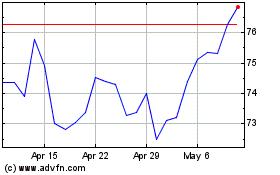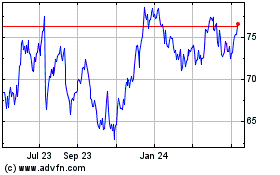FSB Publishes List Of Global SIFIs, Confirms Capital Surcharge
November 04 2011 - 11:01AM
Dow Jones News
The enforcement agency for financial stability of the Group of
20 industrial and developing nations Friday published the
long-awaited list of those banks it will force to hold more capital
because of their importance to the global financial system.
The list of Globally Systemically Important Financial
Institutions is very much as had been expected, with 17 European
banks, eight U.S. ones, three Japanese and one Chinese on it. Two
large European banks, Spain's Banco Bilbao Vizcaria Argentaria SA
(BBVA.MC) and Italy's Intesa Sanpaolo SpA (ISNPY), are conspicuous
by their absence, due largely to their concentration of activities
in their home markets.
The banks named Friday by the FSB have until the end of next
year to lay out in detail how their businesses should be unwound if
they collapse. From 2016, they will also have to hold more capital
than other banks "in order to reflect the greater cost to the
system of their failure." As such, by 2019 at the latest, the
G-SIFIs will have to have a core tier 1 capital ratio up to 3.5
percentage points higher than banks that aren't systemically
relevant.
The FSB foresees five "buckets", requiring extra capital of 1%,
1.5%, 2%, 2.5% and 3.5%. The more important the SIFI, the higher
the surcharge it will have to pay. FSB chairman Mario Draghi said
in Cannes Friday that it is still too early to say which "bucket"
the individual banks will be put in, but the 3.5% "bucket" will be
left empty to start with.
The banks have argued that the surcharges will restrict their
ability to lend to the economy, as well as distorting competition
with their rivals. The regulators largely dismissed those concerns
in confirming the bulk of their original recommendations
Friday.
"Complete and globally consistent implementation of these
measures will be essential for a safer and sounder banking system
and will contribute to broader financial system stability," Stefan
Ingves, chairman of the Basel Committee on Banking Supervision,
said in an e-mailed press statement.
The Basel Committee has stressed that the capital surcharges are
intended as minimum requirements, and has left national regulators
free to impose higher ones.
The FSB said the list of G-SIFIs would be updated in November
every year, while the methodology used to define them would be
reviewed every three years.
As reported, the FSB and the Basel Committee of Banking
Supervision drew up its list of G-SIFIs on the basis of five
criteria: their absolute size, their complexity, the extent of
their cross-border activities and the degree to which they are
interconnected with the rest of the financial system.
The regulators also considered to what extent the banks in
question provided services that couldn't be quickly or adequately
replaced by other banks if they failed.
The full list is as follows:
U.S.: Bank of America (BAC), Bank of New York Mellon , Citigroup
(C), Goldman Sachs (GS), J.P. Morgan (JPM), Morgan Stanley, State
Street (STT) and Wells Fargo (WFC).
U.K.: Royal Bank of Scotland PLC (RBS), Lloyds Banking Group PLC
(LLOY.LN), Barclays PLC (BCS), HSBC Holdings PLC (HBC);
France: Credit Agricole SA (ACA.FR), BNP Paribas SA (BNP.FR),
Banque Populaire, Societe Generale SA (GLE.FR)
Germany: Deutsche Bank AG (DBK.XE), Commerzbank AG (CBK.XE)
Italy: Unicredit Group SA (UCG.MI)
Switzerland: UBS AG (UBS), Credit Suisse AG (CS)
Belgium: Dexia SA (DEXB.BT)
Netherlands: ING Groep NV (ING)
Spain: Banco Santander SA (SAN.MC)
Sweden: Nordea AB (NDA.SK)
Japan: Mitsubishi UFJ FG (8306.TO), Mizuho FG (MFG), Sumitomo
Mitsui FG (8316.TO)
China: Bank of China (BACHY)
State Street (NYSE:STT)
Historical Stock Chart
From Jun 2024 to Jul 2024

State Street (NYSE:STT)
Historical Stock Chart
From Jul 2023 to Jul 2024
